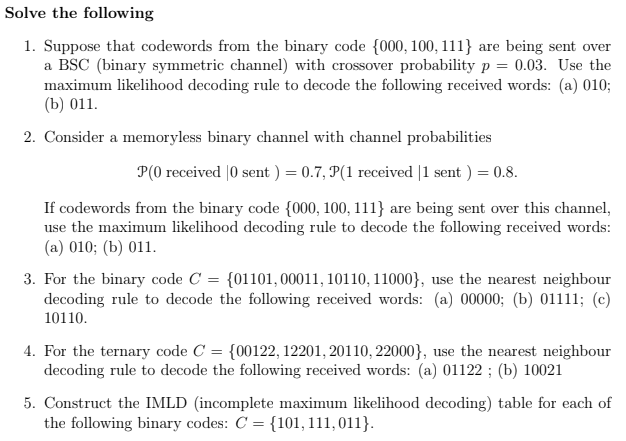Answered step by step
Verified Expert Solution
Question
1 Approved Answer
Formal master degree: pls answer 1-5. Thank you Solve the following 1. Suppose that codewords from the binary code {000, 100, 111} are being sent

Formal master degree: pls answer 1-5. Thank you
Solve the following 1. Suppose that codewords from the binary code {000, 100, 111} are being sent over a BSC (binary symmetric channel) with crossover probability p = 0.03. Use the maximum likelihood decoding rule to decode the following received words: (a) 010; (b) 011. 2. Consider a memoryless binary channel with channel probabilities P(0 received 0 sent ) = 0.7, P(1 received 1 sent ) = 0.8. If codewords from the binary code {000, 100, 111} are being sent over this channel, use the maximum likelihood decoding rule to decode the following received words: (a) 010; (b) 011. 3. For the binary code C = {01101, 00011, 10110, 11000}, use the nearest neighbour decoding rule to decode the following received words: (a) 00000; (b) 01111; (c) 10110 4. For the ternary code C = {00122, 12201, 20110, 22000), use the nearest neighbour decoding rule to decode the following received words: (a) 01122 ; (b) 10021 5. Construct the IMLD (incomplete maximum likelihood decoding) table for each of the following binary codes: C = {101, 111, 011}. Solve the following 1. Suppose that codewords from the binary code {000, 100, 111} are being sent over a BSC (binary symmetric channel) with crossover probability p = 0.03. Use the maximum likelihood decoding rule to decode the following received words: (a) 010; (b) 011. 2. Consider a memoryless binary channel with channel probabilities P(0 received 0 sent ) = 0.7, P(1 received 1 sent ) = 0.8. If codewords from the binary code {000, 100, 111} are being sent over this channel, use the maximum likelihood decoding rule to decode the following received words: (a) 010; (b) 011. 3. For the binary code C = {01101, 00011, 10110, 11000}, use the nearest neighbour decoding rule to decode the following received words: (a) 00000; (b) 01111; (c) 10110 4. For the ternary code C = {00122, 12201, 20110, 22000), use the nearest neighbour decoding rule to decode the following received words: (a) 01122 ; (b) 10021 5. Construct the IMLD (incomplete maximum likelihood decoding) table for each of the following binary codes: C = {101, 111, 011}Step by Step Solution
There are 3 Steps involved in it
Step: 1

Get Instant Access to Expert-Tailored Solutions
See step-by-step solutions with expert insights and AI powered tools for academic success
Step: 2

Step: 3

Ace Your Homework with AI
Get the answers you need in no time with our AI-driven, step-by-step assistance
Get Started


